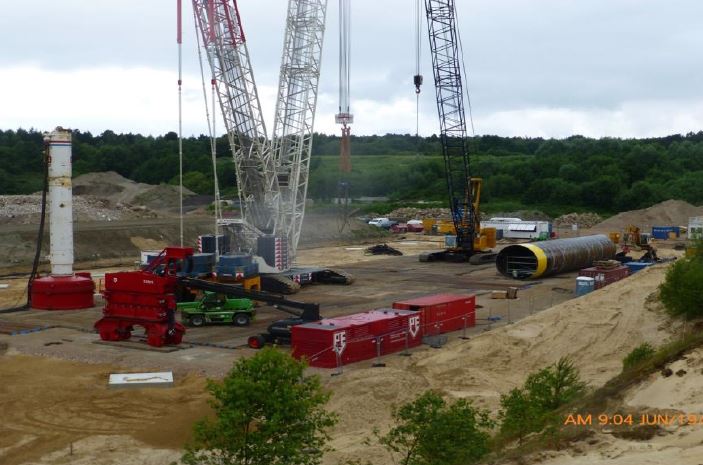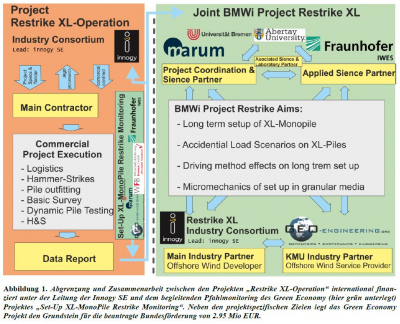- Marine Engineering Geology
- Projects
- Offshore-XL-Monopile
Offshore-XL-Monopile


Project Target
The development of offshore wind energy represents an important element for achieving the energy transition in Germany. The establishment of safe and economical foundation variants for offshore wind farms is a research and development focus of the involved applicants from Bremen.
Recently, a mono-pile foundation for offshore wind turbines (OWEA) of considerable dimensions with diameters larger than 5 meters and more than 100 tons of steel, the so-called XL Monopile, allows the economic construction of larger and more efficient turbines in water depths of more than 30 m. For the assessment of the foundation, soil tests are used before the start of construction. During the piling or vibration work, however, the construction site is fundamentally changed. These installation-related changes can not be taken into account in the calculation and are the current research focus of our joint, ongoing BMWi joint project "Vibro-CPTu". However, the ground change around a XL-Monopile stops not with the completed installation. In most cases, the pile-to-ground coupling increases after installation and the pile can ultimately carry significantly higher loads: a doubling of pile load capacity is possible. Neither the increase in the temporal capacity nor the physical cause and drive of this set-up effect are sufficiently understood to take the increase in load capacity already into account in the calculation.
Within the scope of the internationally sponsored and industry-funded project "Restrike Operation" and under the leadership of INNOGY SE (formerly RWE INNOGY), three vibrated and three rammed experimental pens of the XL-monopile type from the "Vibro Project" on a test site south of Cuxhaven will be reacitvated by piles in the course of dynamic restrikes. This serves to investigate the past growth effect, which decisively determines the actual structural behavior of the foundation variant XL monopile. This industrial-financed project offers our application network the unique opportunity to carry out innovative accompanying measurements.
GEO-ENGINEERING.ORG GMBH plans in the framework of the research project "Set-Up XL-Monopile Restrike Monitoring" presented here:
- To develop an advanced pile monitoring concept for detecting soil changes during ramming and short- and medium-term physical propulsion of pile-growing.
- Using the innovative newly developed concept with the example XL-monopiles accompanying the industry-funded project "Restrike Operation" at the Altenwalde test field.
- To record and view the data before, during and after the ramming.
- To develop the Bremen services "XL Monopile Anwachs Prognosis" in the medium term (Illustration 1).
For this project, GEO- ENGINEERING.ORG GMBH has set up a network with strong, research-based co-applicants FRAUNHOFER-IWES and MARUM / Uni-Bremen. The pre-set project:
- is highly innovative but risky and contributes to the economical use of materials and energy and the avoidance of emissions by strengthening the offshore wind industry;
- Joins a long-standing innovative service development chain around the company's offshore wind energy and its research partners, an example of living technology transfer;
- is based on five successfully launched federal and federally funded research and development projects in the field of offshore wind energy of the last 10 years.
Illustration 1

Project Description
Scientific and technical work goals
The aim of the project is to measure mechanical parameters of the pile-soil system in connection with a dynamic pile load test in order to develop as a long-term aim a prognosis method for the set-up effect of piles. The growth leads to mechanical changes of stresses and deformations on the pile and in the ground (Gavin 2015). The soil itself changes with aging and all these changes cause changes in the dynamic behavior of the pile. In the proposed project, these mechanical parameters are to be determined at critical points before, during and after the dynamic pile load test in order to subsequently investigate the physical mechanisms of set-up in the BMWI project "Restrike XL".
Initially in the project, a measurement concept will be developed that takes into account the details of the test area, the project history and the transmitter. The three-dimensional stress state in the soil should be determined at least in the depth of the pile base and in at least two different distances. Properly predicting the stress conditions in the pile area and their change after the pile rams over the first few months is a challenging test for any soil model. Stress changes always go hand in hand with deformations; how strong the pile itself is involved is to be determined by means of tachymeter measurements and highly precise water level gauges systems. These measurements could give direct clues to different drives of the pile set-up, such as earth tides or daily temperature. The deformation of the soil surface around the pile should also be measured during the pile driving and afterwards. The dynamic deformation and the surface wave damping should be determined with 3-component geophone chains, the material damping with 1-component geophones in the depth of the pile base. The absolute deformation is recorded with tachymeters.
The soil deformation during ramming allows a more accurate description of the dynamic pile-soil interaction, and the ongoing soil deformation is crucial for long-term soil changes. The long-term soil changes themselves shall be determined by two methods, once as in the Vibro project with cone penetration tests, but to a lesser extent. In addition, it is planned to use Multichannel Analysis of Surface Waves, (MASW), which non-destructively measures changes in the ground (Kayen et al., 2013). It is planned to calibrate the results of Multichannel Analysis of Surface Waves with the invasive techniques of cone penetration testing. Low-strain measurements shall be used to determine the natural frequency of the pile, and the change in the natural frequency before and after the Restrike shall be determined. Changes to the pile-to-ground coupling are to be measured as they are closely related to the pile set-up.
The measured data is processed in the project and evaluated with the existing data from the industry project "Restrike Operation" and the other related projects. With this data and other laboratory and field measurements, the physical mechanisms of pile set-up are then explored to later develop a commercially viable prognosis method for the set-up effect.
Joint Project
Project Coordination
Geo-Engineering.org GmbH (GEO-ENG)
Project Lead: Dr. Majid Goodarzi; Dr. Janis Thal
Address: Tucholskystr. 7, 28239 Bremen
Phone: 0421 - 69697789
E-Mail: [Bitte aktivieren Sie Javascript]
E-Mail: [Bitte aktivieren Sie Javascript]
Affiliated Partners
MARUM – Forschungszentrum für Marine Umweltwissenschaften, Universität Bremen
Project Lead: Prof. Dr. Tobias Mörz
Address: Leobener Str. MARUM, 28359 Bremen
Phone: 0421- 218 65840
E-Mail : [Bitte aktivieren Sie Javascript]
Fraunhofer-Gesellschaft zur Förderung der angewandten Forschung e.V.
Hansastr. 27 c, 80686 München
for services of its
Fraunhofer Institute for Wind Energy and Energy System Technology (IWES), Bremerhaven, Working Group Offshore Standortbewertung Bremen



